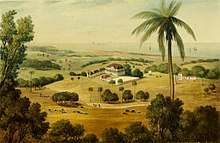Hamilton Brown
Hamilton Brown (1776 – 18 September 1843) was an Irish sugar planter and slave owner in Saint Ann Parish, Jamaica, which he represented in the House of Assembly of Jamaica for 22 years. He gave his name to Hamilton Town in Saint Ann Parish, now Brown's Town, which he founded.
Hamilton Brown | |
|---|---|
| Born | 1776 |
| Died | 18 September 1843 (aged 66–67) Jamaica |
| Nationality | Irish |
| Occupation | Sugar planter |
| Known for | Founded Hamilton Town, now Brown's Town |
Early life
Hamilton Brown was born in 1776,[1] in County Antrim, Ireland.[2]
Career

Brown began his career as an estate bookkeeper[3] but acquired significant land holdings and agricultural interests in Jamaica. He was a pen-keeper (cattle breeder) and was responsible for a large cattle fair held on Pedro Plains in Saint Elizabeth Parish in 1829.[4] He also grew sugar[5] and owned the Antrim, Colliston, Grier Park, and Minard plantations, all in Saint Ann Parish, as well as having interests in numerous others.[2]
He gave his name to Brown's Town, originally known as Hamilton Town, in Saint Ann Parish, which he founded,[3][6] and in 1805 he paid for the construction of the original St Mark's Anglican Church in Brown's Town.[7]
He was a member of the House of Assembly of Jamaica in 1820[8] and represented Saint Ann Parish in that assembly for 22 years.[6] In 1832, he met Henry Whiteley on his trip to Jamaica to whom he argued that Jamaican slaves were better off than the poor of England and therefore the British government should not interfere with the way the Jamaican planters managed their slaves; Whiteley went on to witness harsh and arbitrary whipping of slaves at the plantations that he visited during his stay.[9]
After the emancipation of slaves throughout the British Empire in 1833 by the Slavery Abolition Act, Brown was active in trying to recruit Irish people to work in Jamaica. In December 1835, 121 people from Ballymoney, Antrim, set off from Belfast for Jamaica on the James Ray, a brig owned by Brown. They settled in Saint Ann Parish. In 1836 he brought a further 185 Irish people to Saint Ann. An effort by planters in 1840 to encourage large-scale Irish migration to Jamaica to settle lands that might otherwise be occupied by newly-freed slaves, failed after the project was criticised in Ireland as potentially making slaves of the migrants.[10]
Death
Brown died on 18 September 1843 and is buried in the graveyard of St Mark's Anglican church in Brown's Town.[2][6]
References
- Senior, Olive. (2004) Encyclopedia of Jamaican Heritage. St. Andrew: Twin Guinep Publishers. p. 76. ISBN 978-9768007148
- Hamilton Brown Profile & Legacies Summary. Legacies of British Slave-ownership. University College London. Retrieved 23 January 2019.
- Place Names in St. Ann. The National Library of Jamaica, 2015.
- Gardner, William James. (1873) A History of Jamaica: From its Discovery by Christopher Columbus to the Year 1872 &c. London: Elliot Stock. p. 268.
- Shepherd, Verene A. (2009) Livestock, Sugar and Slavery: Contested Terrain in Colonial Jamaica. Kingston: Ian Randle. p. 93. ISBN 9789766372569
- Uncovering secrets in Brown's Town. Robert Lalah, The Gleaner, 10 July 2012. Retrieved 23 January 2019.
- St Mark's Anglican, Brown's Town, St Ann. Jamaican Ancestral Records. Retrieved 24 January 2019.
- Hakewill, James. (1825) A Picturesque Tour of the Island of Jamaica, From Drawings Made in the Years 1820 and 1821. London: Hurst and Robinson & E. Lloyd. p. 13.
- Whiteley, Henry. [1834] (1833). Three Months in Jamaica, in 1832; Comprising a Residence of Seven Weeks on a Sugar Plantation. Newcastle: Anti-Slavery Society. pp. 3–4.
- Mitchell, Madeleine E. (2008) Jamaican Ancestry: How To Find Out More. Revised edition. Heritage Books. pp. 110–112. ISBN 978-0788442827
Further reading
- Senior, Carl H. "Robert Kerr: Emigrants of 1840 Irish Slaves for Jamaica", Jamaica Journal, No. 42 (1978), pp. 104–116.
External links
![]()